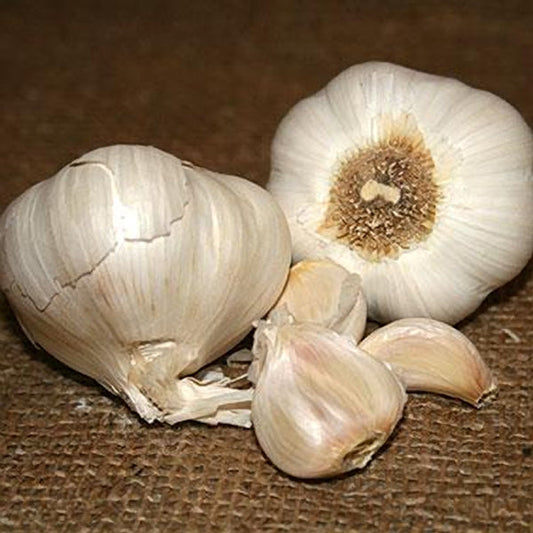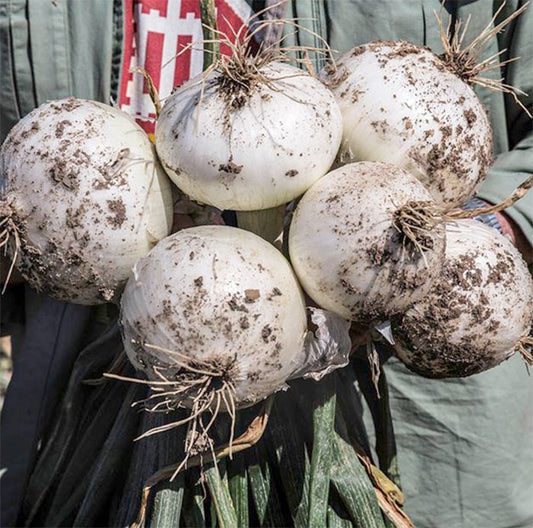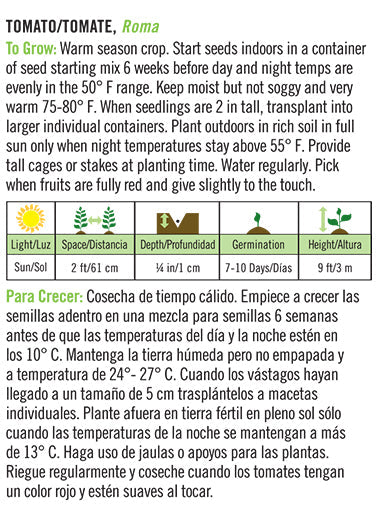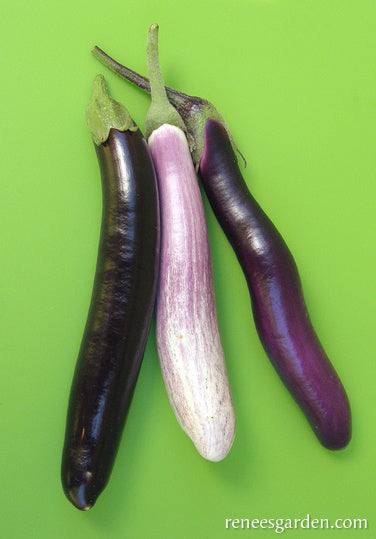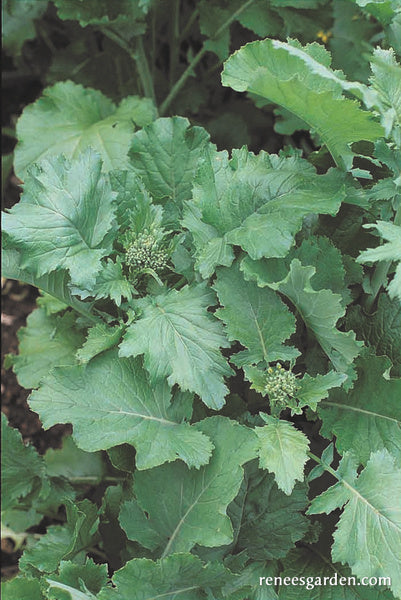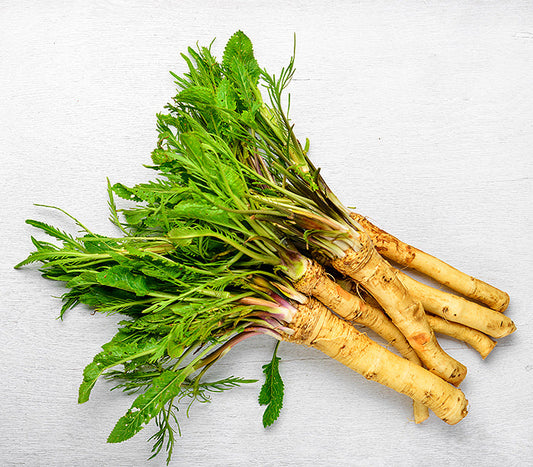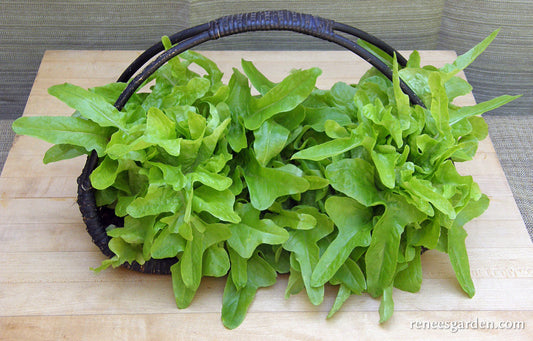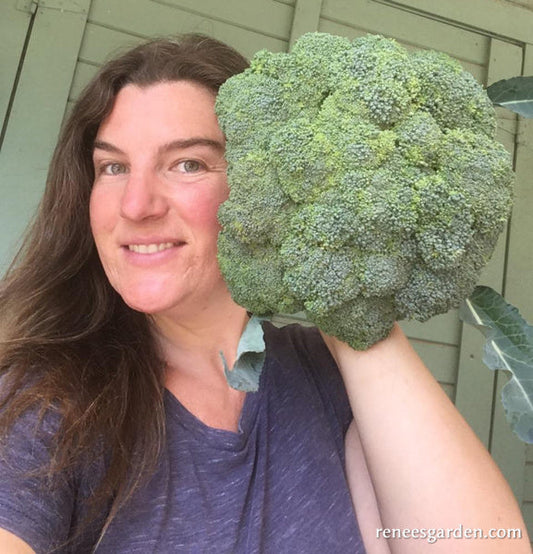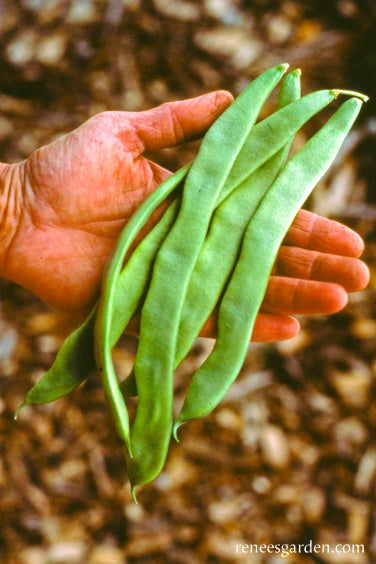Vegetables
Set The Table From Your Garden
-
Long Keeping Onions Blush F1
 A brand-new and unique onion that catches everyone’s eye! A cross between yellow and red onions, Blush produces large, globe-shaped, beautiful onions with shiny, rosy-pink champagne colored wrapper leaves, delicate pink rings and dense, fine textured flesh. This versatile new hybrid is an outstanding, widely adopted home garden variety that can take tough growing conditions. The big 4 inch bulbs have strong skins and store exceptionally well for many months of use.
A brand-new and unique onion that catches everyone’s eye! A cross between yellow and red onions, Blush produces large, globe-shaped, beautiful onions with shiny, rosy-pink champagne colored wrapper leaves, delicate pink rings and dense, fine textured flesh. This versatile new hybrid is an outstanding, widely adopted home garden variety that can take tough growing conditions. The big 4 inch bulbs have strong skins and store exceptionally well for many months of use.
These attractive onions are heavy for their size with crunchy flesh that is mild with just a hint of bite. Marinate slices for 5 minutes in cold water and then add to fresh green salads, or simply slice the Blush bulbs up to melt into succulent sweetness in stirfries, stews, soups, casseroles or as attractive and tasty pizza topping. We guarantee you’ll love them!
5 dozen plantsRegular price $22.95Sale price $22.95Unit price / per -
French Fingerling
This delicious heirloom, first imported from France in the 1950s, is a longtime favorite of restaurant chefs. French Fingerlings have attractive rosy-red smooth and tender skin, rich yellow flesh streaked with red and exquisite flavor. The flesh of this gourmet fingerling looks already buttered and its fine flavor is sweet and nutty, with a dense texture. Their thin skin is very edible and needn’t be removed before eating. The elongated oval tubers size up from 3 to 4 in. long.
These prized fingerlings cook quickly when boiled or roasted whole and they hold their shape, which makes them an excellent casserole or salad potato. Enjoy simply prepared as their superb flavor stands on its own. French Fingerling tubers often set near the surface, so hill plants up well and you’ll be rewarded with abundance.
Late: 95-125 days / Type: Indeterminate
1 lb. bag (plants a 10 foot row)
Mix and match your own potato patch:
Save 10% when you buy any 3 varieties or more!
Discount taken at checkoutRegular price $19.95Sale price $19.95Unit price / per -
Colorado Rose
This excellent new red-skinned potato variety offers high quality, crisp white flesh and smooth skin magenta-red skin, but its beauty goes a lot further than pretty color. You can rely on this great tasting all-purpose potato every season for uniform heavy yields of rosy colored, medium oval shaped tubers that can be used in so many ways, including roasting, mashing, frying, microwaved, or simply steamed for very pretty summer potato salads.
Versatile and productive Colorado Rose offers home gardeners excellent disease resistance to hollow heart, blackspot bruise, and shatter bruise. After harvest, Colorado Rose tubers will keep their color, won't fade in storage, and keep exceptionally well for a long season of use.
Early to Midseason: 80-95 days / Type: Determinate
1 lb. bag (plants a 10 foot row)
Mix and match your own potato patch:
Save 10% when you buy any 3 varieties or more!
Discount taken at checkoutRegular price $19.95Sale price $19.95Unit price / per -
Stalk Celery Merlin
TO PLANT DIRECTLY OUTDOORS
Start celery in spring, when temperatures are above 50°F (10°C) day and night. Plant in full sun or, in hot summer areas, where there is afternoon shade. Celery is a heavy feeder; amend soil well with a high nitrogen fertilizer before planting. Sow seeds thinly, about 1-2 inches apart and cover very lightly. Be patient and keep seedbed evenly moist while awaiting germination which is slow and uneven. When seedlings are 3 inches tall, thin to 8 inches apart to grow to maturity.
TO START EARLY INDOORS
Start in early spring, 8-10 weeks before night temperatures are evenly above 50°F (10°C). Sow seeds thinly in containers of seed starting mix. Cover very lightly. Keep evenly moist; germination is uneven and takes up to 21 days. Keep seedlings at 70°F (21°C) range, providing a strong light source. Feed every 7-10 days with half strength liquid fertilizer like fish emulsion solution. When seedlings are well-established, plant in the garden 8 inches apart, so plants have room to grow and mature.
GROWING NOTES
For growing success and optimum flavor and yield, growing celery plants must be kept consistently moist and well fed. Check often and water regularly; a thick mulch of compost helps maintain moisture. Fertilize every few weeks with a high nitrogen fertilizer or fish emulsion solution. Harvest outside stalks at maturity as needed or cut whole plant.
Regular price $3.39Sale price $3.39Unit price / per -
Heirloom Pole Beans Kentucky Wonder
START SEEDS OUTDOORS
In late spring, once night temperatures stay securely above 55°F(13°C), plant seeds in well-worked, fertile soil in full sun. Erect strong stakes, tripod poles or trellis, at planting time to support vines. Plant 1 inch deep and 4 inches apart along a trellis; around tripods or stakes, plant 4 to 6 seeds about 4 inches from each pole, thinning seedlings to 3 best plants per pole.
GROWING NOTES
Beans are an easy and reliable crop, but don’t plant seeds too early; cold conditions prevent good germination. If first sowing comes up unevenly, replant right away; new seedlings will catch up quickly. Birds are attracted to young seedlings; watch carefully and protect with netting if necessary. Avoid harvesting beans in wet conditions.
HARVEST AND USE
For the best yields, pick beans frequently, at least every 2 or 3 days. These tasty beans are delicious freshly harvested and the more pods you pick, the more plants will produce. Enjoy quickly steamed just until tender-crisp, then toss with a little sweet butter and a sprinkling of fresh tarragon or dill.
Regular price $4.89Sale price $4.89Unit price / per -
Top Flavor Carrots Napoli
START SEEDS OUTDOORS
In spring once danger of hard frost is past, sow seeds in full sun in finely worked, fertile soil. Sow 1/4 inch deep and 1/2 inch apart in rows 8 inches apart, or broadcast thinly in beds and cover lightly. Keep seedbed evenly moist as carrots can be slow to germinate, emerging over 10 to 20 days. If first sowing comes up unevenly, replant right away as seedlings catch up quickly. Be sure to thin young carrots several times so seedlings are about 2 inches apart and have room to size up.
GROWING NOTES
Carrots like well worked soil and need consistent moisture to grow well. If your soil tends to dry out, cover seedbed with floating row cover to help retain moisture during the germination period and water right through it. Keep carrots well watered and thinned. For a late season crop, sow again 3 months before first expected frost.
HARVEST AND USE
Let young carrots size up and color fully to orange before harvesting for best flavor. Saute or steam just until tender crisp and serve with a squeeze of fresh lemon or lime juice, sweet butter and fresh dill; or try buttered and glazed with a little maple syrup or honey.
Regular price $4.89Sale price $4.89Unit price / per -
Container Chile Peppers Early Flame Jalapeños
STARTING SEEDLINGS
Start indoors 8 weeks before outdoor night temperatures reach 55°F (13°C). Sow seeds 1/4 inch deep and 1 inch apart in a container of seed starting mix. Keep moist but not soggy, and very warm 80°F (27°C). Provide a strong light source until ready to plant outdoors. When seedlings are several inches tall, transplant into 4 inch pots. Keep warm; 70°F (21°C). Feed with half-strength liquid fertilizer.
When nights reach 55°F (13°C), acclimate seedlings to outdoor conditions. If planting in garden beds, space 2 feet apart in rich soil in full sun.
CONTAINER GROWING
Transplant each well-developed seedling into a container about 15 inches tall and deep. Use fresh potting mix to prevent soil borne diseases. Fertilize 2 times per month with all-purpose fertilizer for best plants and bigger yields. Check often and water regularly; plants usually require daily watering in hot summer weather.
GROWING NOTES
Peppers need full sun at least 6 hours per day. Mulch well to maintain even moisture. Provide short stakes or cages to support the heavy sets of ripening fruit. Keep growing plants well watered and fed.
HARVEST AND USE
To harvest, cut rather than pull fruits from plants when deep glossy green or colored up red. Enjoy Jalapeños in sandwiches, fresh salsas, sauces, fajitas and marinades. They are delicious sliced and quickly pickled or stuffed with cheese and baked.Regular price $4.99Sale price $4.99Unit price / per -
Container Cucumber Bush Slicer
START SEEDS OUTDOORS
Plant heat loving cucumbers only when spring weather is warmed and night temperatures are consistently above 55°F (13°C). Amend soil well with aged manure or compost. Sow seeds 1 inch deep and 4 inches apart in slightly mounded hills that are 3 feet apart, sowing 4 or 5 seeds in each hill. Thin to the 3 strongest seedlings in each hill so plants have room to grow and mature.
FOR CONTAINERS
Sow seed directly into containers 4 inches from edges. When plants are 3 to 4 inches tall, thin carefully to strongest seedlings. Final spacing should be one plant per pot 12 inches deep and 12 inches across or 2 plants in a larger container at least 18 inches across. For larger planters, grow plants at final spacing of 8 to10 inches apart.
GROWING NOTES
Protect seedlings from marauding birds with plastic berry baskets, removing before plants get crowded. Feed every other week. A good mulch will aid shallow rooted cucumber plants, which require ample and consistent moisture in hot dry weather. Avoid overly wet or dry periods for good quality fruit. In hot dry weather, check and water plants in containers daily.
HARVEST AND USE
Keep all mature cucumbers picked; fruits left on vines will signal the plant to stop producing. Cut rather than pull fruits from vines. Slice them up for refreshing snacks, salads and sandwiches. Eat within a day or two of picking for best taste and quality.
Regular price $3.39Sale price $3.39Unit price / per -
Italian Late
This late maturing variety will nicely extend your garlic harvest and is well worth waiting for. The rounded, medium size bulbs have cream colored, tight wrapper skins that keep the fat garlic cloves inside them fresh. Italian Late has a balanced flavor with medium heat and spiciness.
You can rely on Italian Late for consistent good flavor and longer keeping than other softneck garlics. Grow Italian Late for an extended fresh garlic season.
Late-season maturity.
See All Garlic and Shallots
1/2 lb. bag (3-6 full heads) / SoftneckRegular price $17.95Sale price $17.95Unit price / per -
German Red
We heartily recommend this robust and hardy garlic from the rocambole family for strong, reliable harvests in cold winter climates where the ground freezes hard. The easy to peel bulbs have striking reddish cloves around a center stalk. Garlic lovers look forward to its spicy, deliciously bold taste.
Used raw, sautéed or roasted, German Red’s zesty flavor lends itself to any dish where garlic is important to make flavor combinations sing. Great for garlic bread! Super in pesto! Enjoy German red first; it is truly delicious, but doesn’t store as long as other varieties. Mid-season maturity.
See All Garlic and Shallots
1/2 lb. bag (3-6 full heads) / HardneckRegular price $17.95Sale price $17.95Unit price / per -
Italian Early
Originally from Italy, this classic favorite is always widely grown in Gilroy, California, known as the “garlic capital” of the world. Italian Early’s big, white bulbs have purple streaks at their base and large, milky-white, spicy cloves. Its well rounded flavor enhances every recipe.
This is a good variety for making garlic braids to store your harvest or give as gifts. Italian Early is better adapted to mild climates and summer heat than many other garlic varieties. Ready to harvest early and an excellent keeper. Early-season maturity.
See All Garlic and Shallots
1/2 lb. bag (3-6 full heads) / SoftneckRegular price $17.95Sale price $17.95Unit price / per -
Asparagus Crowns Millennium
This new variety, bred in Ontario, Canada, is a superior all-around performer and has quickly become the new standard for asparagus quality and production. Millennium is a vigorous grower with strong spring emergence in various soil types including heavier soils.
Higher yielding than Jersey giant or Jersey Supreme, Millennium’s top quality plants put all their energy into producing particularly tender, succulent spears. Millennium has excellent rust resistance, fusarium tolerance, and is productive in both mild and very hard winter areas.
You’ll be rewarded with regular uniform harvests of 7 to 9 inch, delectable, bright green crunchy spears, delicious whether steamed, roasted, stirfried or sautéed.
25 Crowns – Limited Quantities: Order Now
Asparagus roots ship directly from our grower beginning in early April. Shipping dates depend on your climate zone and weather in transit. See shipping chart. See More About Our Asparagus Crowns
See More About Our Asparagus Crowns Please Provide a Street Address for Shipping; we cannot ship this item to a PO box.
Regular price $39.95Sale price $39.95Unit price / per -
Nootka Rose
This Northwest heirloom garlic hails originally from the San Juan Islands in Washington. It is a handsome garlic with medium to large bulbs, often streaked in rosy-red. Nootka Rose offers garlic lovers strong spicy flavor, delicious aroma and some real heat.
Nootka Rose grows reliably and sizes up nicely. These handsome bulbs with their robust flavor are a favorite of garlic lovers who love to cook. The bulbs keep very well for prolonged enjoyment at the table. Late-season maturity.
See All Garlic and Shallots
1/2 lb. bag (3-6 full heads) / SoftneckRegular price $17.95Sale price $17.95Unit price / per -
Sweet and Mild Onions Ringmaster
An outstanding and improved strain of Sweet Spanish onion, Ringmaster has white flesh and milky white skins. It produces very large globe-shaped onions with really crisp, mild, sweet flesh. These long day onions are heavy producers and excellent storage onions that keep for 4-5 months. Ringmaster is resistant to pink root disease.
Ringmaster onions have thick crispy rings surrounding a single center, making them just perfect to slice for succulent onion rings or for garnishing burgers. They also delicious sliced up in sandwiches and wonderful for tacos and chopped salads.
5 dozen plantsRegular price $22.95Sale price $22.95Unit price / per -
All Purpose Onions Super Star F1
This fine All-America winning hybrid onion is a truly a star performer well deserving of its coveted award. Superstar will grow and produce abundantly in almost anywhere in the country because it is a day neutral onion. Their strong tall foliage protects the big bulbs from sunburning and plants are resistant to pink root.
Super Star yields big harvests of big shiny white mild tasting bulbs sweet enough to eat raw in sandwiches and salads. After harvest, these beautiful, creamy white, crispy onions store very well for long-term enjoyment. If planted early in spring, individual onions can reach 1 pound or more!
5 dozen plantsRegular price $22.95Sale price $22.95Unit price / per -
'Roma' Tomato/Tomate - Spanish/English
Ideal for the gardener who cooks. This Italian paste-type tomato produces vigorous plants with an abundance of meaty fruits that are perfect for flavorful sauces or ketchup. Determinate (VFN).Regular price $2.19Sale price $2.19Unit price / per -
Specialty Eggplants Asian Trio
BEST TO START INDOORS
In early spring, start indoors about 2 months before outdoor night temperatures are reliably in the 50-55°F (10-13°C) range. Sow seeds 1/4 inch deep and 1 inch apart in a container of seed starting mix. Keep moist and warm 80-85°F (27-30°C) and provide a strong light source until ready to plant outside. When seedlings are 2 inches tall, transplant into deeper individual containers. Maintain at 70-75°F (21-24°C). Feed with half-strength fertilizer every 2 weeks until weather is warm enough to gradually acclimate seedlings to outdoor conditions. Transplant 2 feet apart into rich soil in full sun.
GROWING NOTES
Don’t transplant these heat-lovers outdoors until nights stay securely above 55°F (13°C). Prepare soil well with aged manure or compost. Plant only robust seedlings with well-developed roots and mulch well. Fertilize plants regularly throughout the season.
HARVEST AND USE
Pick when fruits have sized up and are firm fleshed and glossy. Harvest Charming babies at 3 to 6 inches, Asian Bride at 7 to 8 inches, and Farmers Long at 9 to 11 inches, or before fruits get dull and seedy. Slice for great sautés or halve lengthwise, brush with oil and grill with your favorite herbs and cheese or Asian-style seasonings.
Regular price $3.69Sale price $3.69Unit price / per -
Heirloom Broccoli Raab Super Rapini
START SEEDS DIRECTLY IN THE GARDEN
In very early spring as soon as ground can be worked, prepare a well-drained, fertile garden bed in full sun. Sow seeds 2 inches apart in rows 6 to 8 inches apart. Cover 1/4 inch deep and keep soil evenly moist to ensure good germination. When seedlings are 3 to 4 inches tall, thin to stand 4 to 6 inches apart.
GROWING NOTES
Sow Broccoli Raab in cool early spring weather, about the same time as you plant turnips and radishes. Consistent moisture, early thinning and an adequate supply of nitrogen will encourage the quick growth needed to produce tender juicy shoots with plump buds. Use non-toxic B.T. (Bacillus thuringiensis) products to control caterpillar pests as necessary. Make several sowings a week apart for a continuous harvest. Sow again in late summer for a fall crop.
HARVEST AND USE
Harvest both leaves and flowering stalks at 7 to 8 inches tall, when they are still tender and juicy and the flower buds are plump and closed. After cutting, water plants and feed with fish emulsion solution to get a second harvest in a few weeks. Enjoy the hearty flavor of these vitamin-rich greens by briefly steaming or prepare traditionally by first blanching quickly in a boiling water bath, and then sautéing them in olive oil with chopped garlic.
Regular price $3.39Sale price $3.39Unit price / per -
Specialty Eggplants Italian Trio
BEST TO START INDOORS
In early spring, start indoors about 2 months before outdoor night temperatures are reliably in the 50 (10°C) range. Sow seeds 1/4 inch deep and 1 inch apart in a container of seed starting mix. Keep moist and warm and provide a strong light source until seedlings are ready to plant outside. When seedlings are 2 inches tall, transplant into deeper individual containers. Maintain at 70 to 75° (21-24°C). Feed with half-strength fertilizer every 2 weeks until weather is warm enough to gradually acclimate seedlings to outdoor conditions. Transplant 2 feet apart into rich soil in full sun.
GROWING NOTES
Don’t transplant these heat-lovers outdoors until night temperatures stay securely above 55° (13°C). Prepare soil well with aged manure or compost. Plant only robust seedlings with well-developed roots and mulch well. Fertilize plants regularly throughout the season.
HARVEST AND USE
Pick when fruits have sized up and are firm fleshed and glossy. Slice 1/2 inch thick, brush with olive oil and broil until tender. Then layer with a rich tomato sauce, fresh herbs and several cheeses to make Eggplant Parmesan. Bake whole in a hot oven, then scoop out flesh and mash with garlic, olive oil, lemon juice and chopped parsley for a savory dip to serve on toasted pita bread.
Regular price $3.69Sale price $3.69Unit price / per -
Pole Beans Yard Long Noodle King
START SEEDS OUTDOORS
In late spring, once night temperatures stay securely above 55°F (13°C), plant seeds in well-worked, fertile soil in full sun. Erect strong stakes, tripod poles or trellis at planting time to support vines. Plant 1 in. deep & 4 inches apart along a trellis; around tripods or stakes, plant 4 to 6 seeds about 4 in. from each pole, thinning seedlings to 3 best plants per pole.
GROWING NOTES
Yard Long beans are easy to grow as long as you have plenty of sunshine & warm weather. Do not plant too early as cold conditions prevent good germination & growth. If first sowing comes up unevenly, replant right away; new seedlings will catch up quickly. Birds are attracted to young seedlings; watch carefully & protect with netting if necessary. Avoid harvesting beans in wet conditions.
HARVEST AND USE
For the best yields, pick beans frequently, at least every 2 or 3 days. Harvest these astonishingly long, crispy pods when beans are still pencil thin, the pods snap when bent & before the seeds have filled out inside; generally when about 12 to 18 inches long. If the pods get too thick & bulky, they will be fibrous & tough.
Chop the green, skinny pods into 2-3 inch pieces & quickly stirfry or sauté to enjoy their mild, nutty flavor. Try quickly cooking them Asian style with sautéed garlic & ginger, finishing the dish with a little toasted sesame oil & sesame seeds or toasted peanuts. You’ll love them!
Regular price $4.99Sale price $4.99Unit price / per -
Horseradish Roots Big Top
Our easy to grow, premium variety is prized for its size, vigor, wide adaptability and disease resistance. Once planted, each root will produce big sword-shaped green leaves above ground, while the root multiplies and sizes up over the growing season. In late fall, you can dig up plenty to use in making your own spicy horseradish.
You can rely on our Planting and Use Guide (printed copy included with every order) for complete planting, growing, and harvesting information and directions for making homegrown prepared horseradish. Enjoy the wonderful flavor burst of your own horseradish sauce made fresh from the garden!
Each order includes: 2 starter roots, ready to plant.
 See More About Our Horseradish Roots Regular price $18.95Sale price $18.95Unit price / per
See More About Our Horseradish Roots Regular price $18.95Sale price $18.95Unit price / per -
Heirloom Lettuce Baby Oakleaf
START SEEDS OUTDOORS
In cool spring weather, start seeds in full sun. Sow seeds 1/4 nch deep and 1 inch apart in fertile, well-drained soil. When seedlings are several inches tall, thin to a final spacing of 4-5 inches apart. Extra seedlings can easily be transplanted elsewhere.
Container Spacing: Grow 3 plants in an 8 inch pot, or 7 to 8 plants in a 12 to 15 inch diameter container.
GROWING NOTES
Lettuce thrives in cool conditions with consistent moisture. Be sure to thin properly and keep evenly moist for sweet tasting, full heads. For a constant supply, make several sowings a few weeks apart until summer weather turns hot. Plant again in late summer for fall harvest. In hot weather, give lettuce some afternoon shade to extend harvest season and check water daily. Keep soil evenly moist and feed with liquid fertilizer every 2 weeks.
Consider transplanting lettuce seedlings around the edges of a big pot containing a young tomato or pepper plant. The lettuces will be ready to eat just as the bigger plant grows larger and needs the space.
HARVEST AND USE
Savor young thinnings in your first spring salads. Then harvest plants by cutting mature heads when they feel firm and well-filled out. Pull over-mature plants if they begin to elongate (“bolt”) in hot weather, as leaves turn bitter at this stage.
Regular price $3.39Sale price $3.39Unit price / per -
Main Crop Broccoli Bravado
BEST TO START INDOORS
Start seeds 4 or 5 weeks before last expected spring frost and again in midsummer for a fall crop. Sow seeds 1 inch apart in a container of seed starting mix, cover 1/2 inch deep and keep evenly moist. Provide a strong light source until seedlings are ready to plant out. When seedlings are 3 to 4 inches tall, gradually acclimate to outdoor conditions, then transplant 12 to 18 inches apart into rich, well-drained soil in full sun.
TO START OUTDOORS
Sow seeds in well-worked, fertile soil in full sun. Plant groups of 2 to 3 seeds 1/2 inch deep and 12 inches apart. Space rows 18 inches apart. Thin to 1 strong seedling per group so plants have room to mature and grow.
GROWING NOTES
Broccoli needs rich, fertile soil and cool growing weather to produce big heads. Prepare soil well and do not let seedlings get too crowded before thinning or transplanting or the heads will be stunted. Keep well watered and weeded. Feed at least monthly with all purpose fertilizer. Use non-toxic B.T. (Bacillus thuringiensis) products to repel caterpillar pests as necessary.
HARVEST AND USE
Harvest the main head before florets open by cutting about halfway down the stalk. This will encourage numerous side shoots to form for extended picking from each plant.
Regular price $3.69Sale price $3.69Unit price / per -
Early Pole Beans Spanish Musica
START SEEDS OUTDOORS
In spring once weather is warm and night temperatures stay securely above 55°F (13°C), plant seeds in well-worked, fertile soil in full sun. Erect strong stakes, tripod poles, or trellis at planting time to support vines. Plant seeds 1 inch deep and 4 inches apart along a trellis, or if planting around tripods or stakes, plant 4 to 6 seeds 4 inches from each pole, thinning seedlings to 3 best plants.
GROWING NOTES
Tender crispy beans are an easy reliable crop to grow, but do not plant seeds too early as cold conditions prevent good germination. If first sowing comes up unevenly, replant right away; new seedlings will catch up quickly. Birds are often attracted to young bean seedlings, so watch carefully and protect with netting or floating row covers if necessary. Avoid cultivating plants or picking pods when plants are wet.
HARVEST AND USE
Musica’s strong vines are heavy bearers, so plan to harvest often. The more you pick, the more plants will produce. Harvest when beans are broad and 7 to 9 inches long. Slice in pieces and cook just until tender to enjoy their fine flavor and meaty texture. Serve hot, or cool and toss with herbed vinaigrette for a delicious green bean salad.
Regular price $4.99Sale price $4.99Unit price / per

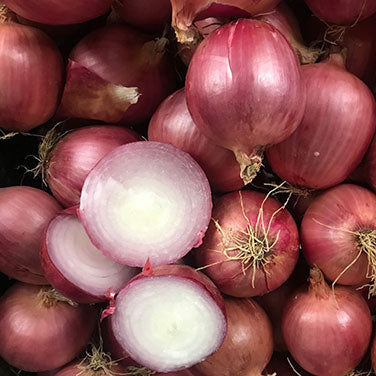
 A brand-new and unique onion that catches everyone’s eye! A cross between yellow and red onions, Blush produces large, globe-shaped, beautiful onions with shiny, rosy-pink champagne colored wrapper leaves, delicate pink rings and dense, fine textured flesh. This versatile new hybrid is an outstanding, widely adopted home garden variety that can take tough growing conditions. The big 4 inch bulbs have strong skins and store exceptionally well for many months of use.
A brand-new and unique onion that catches everyone’s eye! A cross between yellow and red onions, Blush produces large, globe-shaped, beautiful onions with shiny, rosy-pink champagne colored wrapper leaves, delicate pink rings and dense, fine textured flesh. This versatile new hybrid is an outstanding, widely adopted home garden variety that can take tough growing conditions. The big 4 inch bulbs have strong skins and store exceptionally well for many months of use.
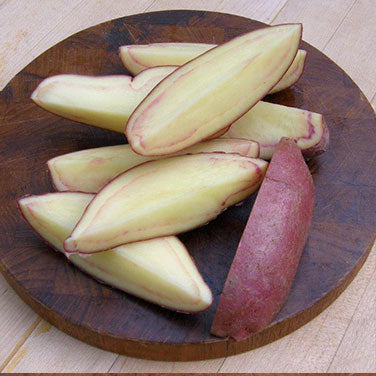

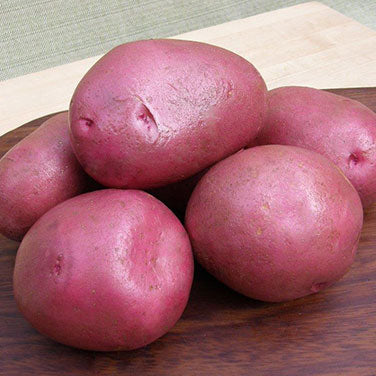

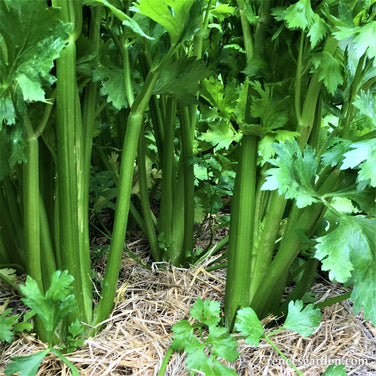

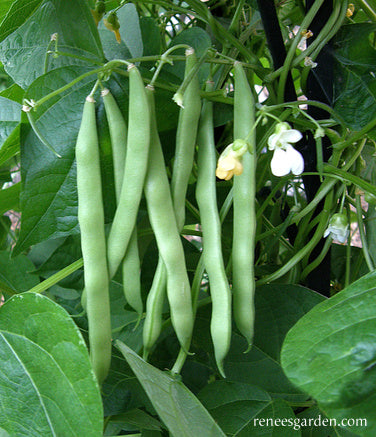

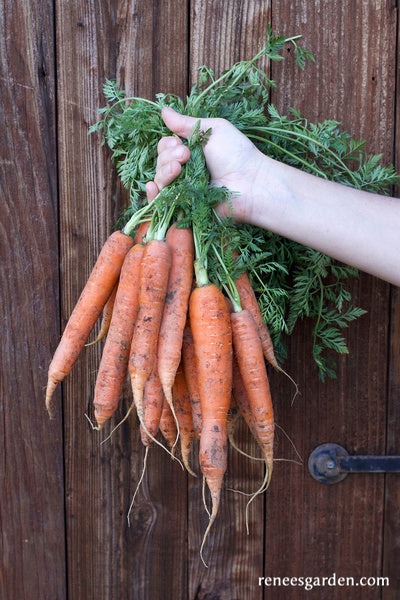

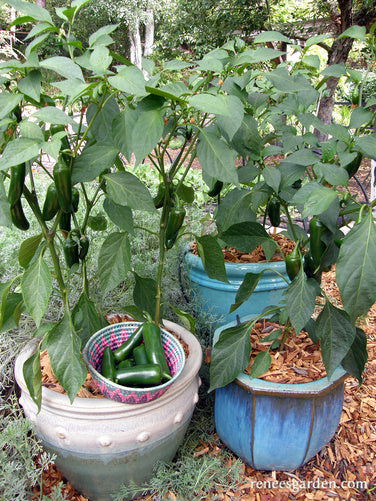

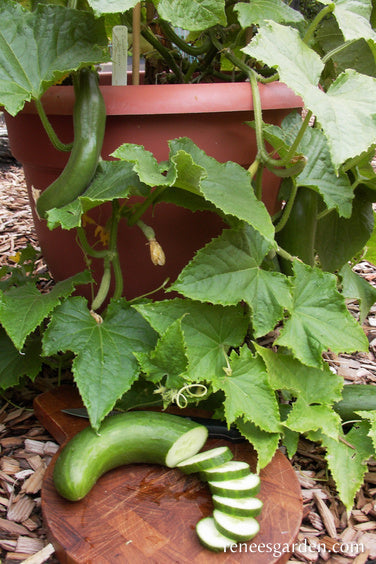

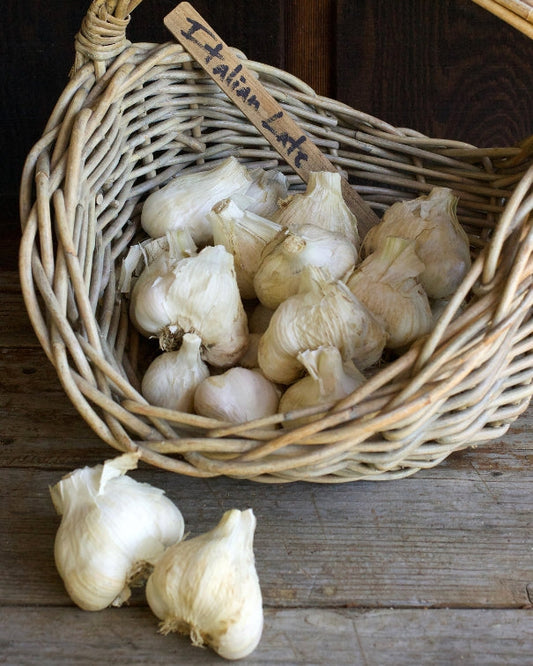

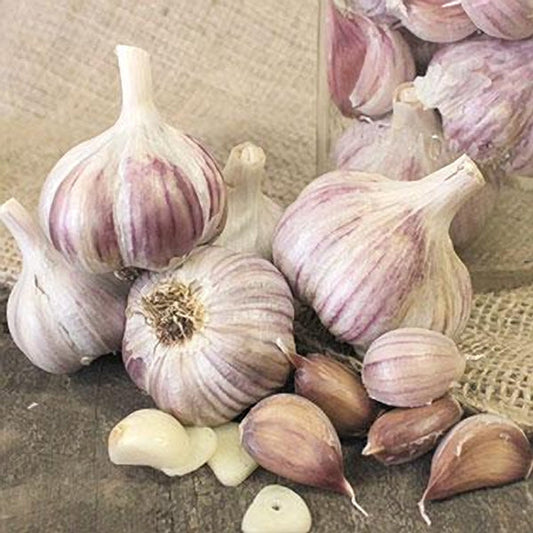

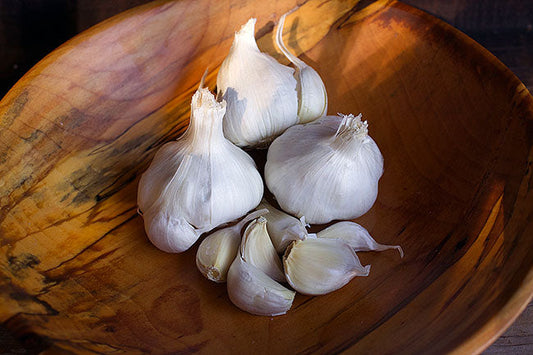

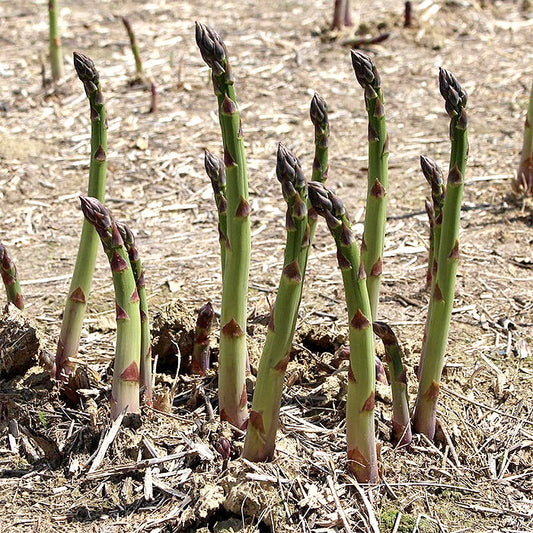
 See More About Our Asparagus Crowns
See More About Our Asparagus Crowns
